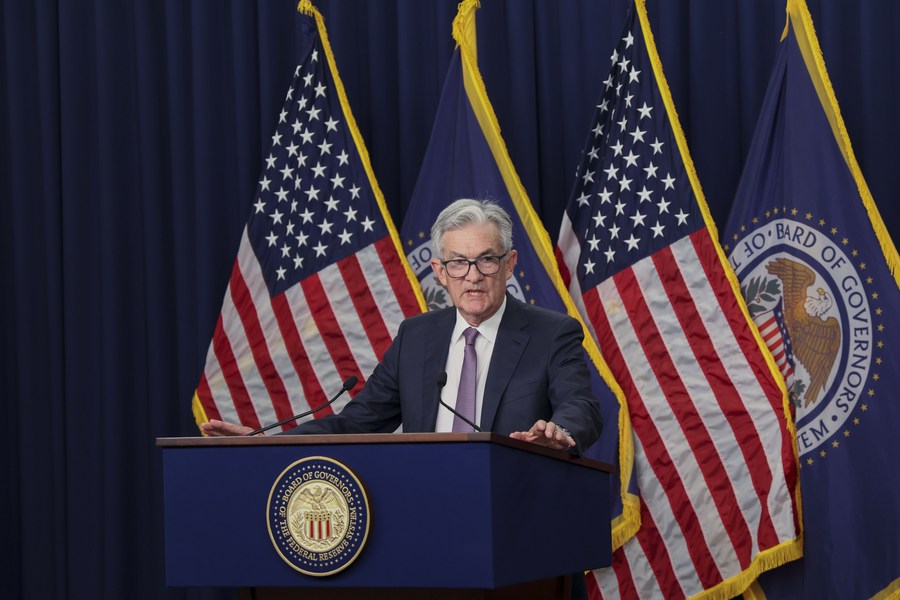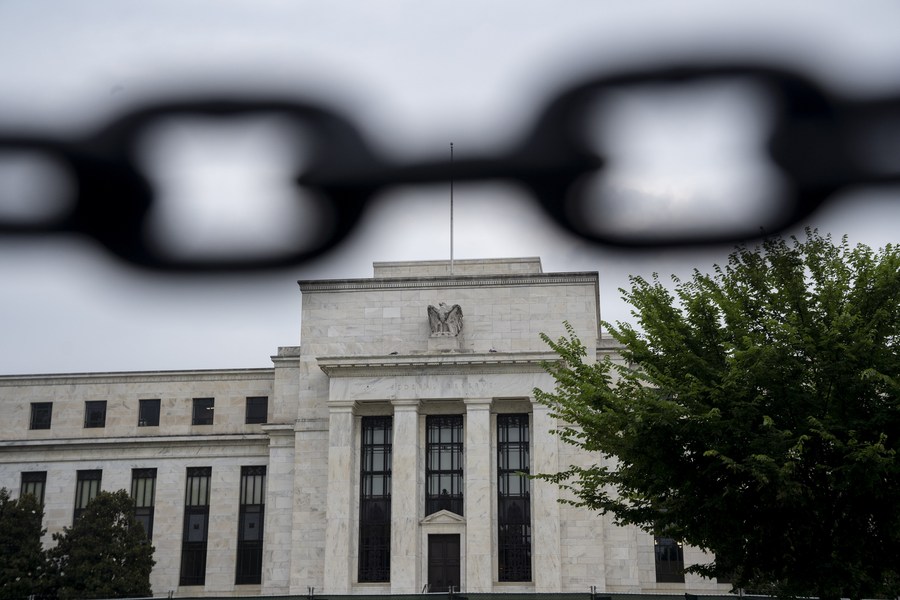
U.S. Federal Reserve Chair Jerome Powell attends a press conference in Washington, D.C., the United States, on Sept. 21, 2022. (Photo by Alexander Norton/Xinhua)
"It seems that the Fed is unnecessarily risking the attainment of its employment objective by pursuing an overly aggressive monetary policy to regain control over inflation," says Desmond Lachman.
by Xiong Maoling
WASHINGTON, Sept. 22 (Xinhua) -- The U.S. Federal Reserve on Wednesday enacted the third consecutive three-quarter-point rate hike and signaled a more hawkish path ahead, as it continued to ramp up its fight against surging inflation.
The central bank, which has cautioned strongly against prematurely loosening policy, acknowledged that the process to get inflation under control could push up unemployment and inflict hardship on households and businesses. Economists warn that Americans should brace for more pain as recession risks grow.
MORE HAWKISH PATH
The Federal Open Market Committee (FOMC), the Fed's policy-setting body, decided to raise the target range for the federal funds rate to 3 to 3.25 percent and "anticipates that ongoing increases in the target range will be appropriate," the Fed said in a statement after a two-day policy meeting.
The Fed's latest action came after it raised the benchmark interest rate by three quarters of a point (75 basis points) at both its June and July meetings, marking the boldest move in decades.
The Fed's latest move came as recent inflation data surprised to the upside. The Consumer Price Index (CPI) in August surged 8.3 percent from a year ago, slightly down from the previous month but still at an elevated level. The CPI has remained over 8 percent since March.
"My main message has not changed at all since Jackson Hole," Fed Chair Jerome Powell said at a press conference Wednesday afternoon, referring to his annual policy speech in late August, when he said the historical record cautions strongly against "prematurely loosening policy."
"The FOMC is resolved to bring inflation down and we will keep at it until the job is done," Powell said.
The Fed's newly released quarterly economic projections showed that the median FOMC projection for the federal funds rate at the end of this year has jumped to 4.4 percent, higher than the 3.4 percent projected in June. The median projection for the 2023 year-end federal funds rate is 4.6 percent.
To reach the median estimate, the Fed would need to lift rates by another 125 basis points at the next two meetings later this year.
"The FOMC further stepped up its inflation-fighting game in September," Jay Bryson, chief economist at Wells Fargo Securities, wrote in an analysis with his colleagues, noting that the committee "delivered a more hawkish projected path" for short-term rates through this year and next.
According to the Chicago Mercantile Exchange Group's FedWatch tool, the probability of a 75-basis-point rate hike at the Fed's next policy meeting in early November was nearly 70 percent by Wednesday night.
Powell said the Fed will be looking for "compelling evidence" that inflation is moving down. "At some point as the stance of policy tightens, it will be appropriate to slow the pace of increases while we assess how our policy adjustments affect the economy," he added.

Photo taken on June 22, 2022 shows the U.S. Federal Reserve building in Washington, D.C., the United States. (Xinhua/Liu Jie)
MORE PESSIMISTIC OUTLOOK
Although a 75-basis-point increase appears to be the "new normal," some economists frown upon the Fed's aggressive moves.
"It seems that the Fed is unnecessarily risking the attainment of its employment objective by pursuing an overly aggressive monetary policy to regain control over inflation," Desmond Lachman, senior fellow at the American Enterprise Institute, told Xinhua.
Lachman believes that the Fed "might have been better served" by a 50-basis point interest rate hike Wednesday and by "waiting to see the lagged impact of its monetary policy tightening to date."
The Fed's quarterly economic projections showed that Fed officials' median projection of unemployment is 4.4 percent by end of 2023, an upward revision of 0.5 percentage point from the June projection.
The projections also showed that the median FOMC projection of GDP growth this year is 0.2 percent, a further downgrade from the 1.7 percent projected in June, indicating less confidence in the economic outlook amid rising rates.
"That's a very slow level of growth and it could give rise to increases in unemployment," said Powell. "We have got to get inflation behind us. I wish there were a painless way to do that. There isn't."
The Fed chief also acknowledged that restoring price stability while achieving a relatively modest increase in unemployment and a soft landing would be "very challenging." He said the chances of a soft landing "are likely to diminish" if policy "needs to be more restrictive or for longer."
Dean Baker, senior economist at the Center for Economic and Policy Research, recently told Xinhua that Powell is prepared to take strong action against inflation, at the price of higher unemployment. "It is very worrying since recent data indicate a slowing of inflationary pressures," said Baker.
In an interview with CNBC, DoubleLine Capital CEO Jeffrey Gundlach said the Fed should ease the pace of rate hikes as the economy is on the brink of a recession. "I think the odds of a recession in 2023 are very high ... I would put them at 75 percent," he said.
Lachman told Xinhua that one reason to fear a "full-blown economic recession" are the acute difficulties already being experienced in the housing market.
Another reason for concern is that the Fed's hawkish monetary policy stance has already caused the bursting of the equity and credit market bubble, he said.
Lachman, who is also a former official at the International Monetary Fund, added that by causing a surge in the dollar and the repatriation of capital from the emerging markets, "it is compounding an already very troubled world economy." (Matthew Rusling contributed to the report) ■












